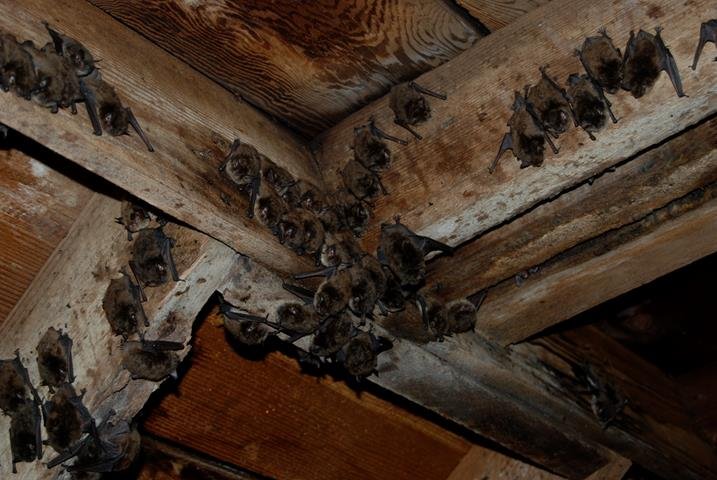Bat Urine Removal and Urine Stain Removal

Bats can be disgusting, and homeowners often require bat feces and urine stain removal after an infestation. During the day, the bats roost upside down, sleeping and dropping their waste down. Thus they leave piles of guano and urine that need to be cleaned. If not dealt with quickly, the excrement will seep into wood and drywall, leaving unpleasant stains.
The guano contains fungus, which grows and can be dangerous to one’s respiratory system. The bats’ waste produces a terrible smell and is corrosive to certain things such as woods and metal. The urine or feces can also attract pests such as rodents and insects. To protect your home from stains, damage, and bacteria, contact Animals Happen at the first sign of bats in the attic. Gives us a call at 833-633-1120 to connect with a local bat control expert.
Where To Find Stains Caused By Bat Guano Or Urine?
Bat urine or guano stains are usually dark, muddy-looking stains and the most likely spot to discover them is beneath the bat’s roost, which is usually in the attic of a home. Another typical spot where stains might accumulate, especially in more extensive bat colonies that have been established for some time, is on the wall below where the bats’ roost departure points in a roof space are located. There are many more places where the stains can appear, like any spot where bats have been around for a long time would display urine stains. 1Go To Source portal.ct.gov -“Living With Bats”
Professional Bat Feces And Urine Stain Removal
 After getting rid of the bats from your home, the guano cleanup and stain removal process can begin. The bats’ urine will soak into the woods and cause corroding of metal, thus becoming difficult to remove. The following steps are how bat decontamination experts solve this issue.
After getting rid of the bats from your home, the guano cleanup and stain removal process can begin. The bats’ urine will soak into the woods and cause corroding of metal, thus becoming difficult to remove. The following steps are how bat decontamination experts solve this issue.
The first task is to vacuum up all leftover feces in the attic. Professionals do this while wearing gloves, goggles, and respiratory maks to ensure they don’t contract any diseases contained in the feces.
The next step is to clean any insulation that the bats’ droppings have soiled. If the infestation is caught early, the feces can be removed, and the insulation may not need replacement. If the bat colony has had time to establish itself, insulation will likely need to be replaced due to the continuous activity of feces and urine being dropped on it.
After the feces and urine has been removed, the stain removal phase can begin. Wildlife technicians will scrub down stains using powerful bacteria-eliminating chemical solutions. Powered brushes allow the technicians to scrub stains out of almost all surfaces. If the stain is unremovable, it’s likely because the excrement has seeped too far into the structure, and repairs will be required.
After the infested area is stainless, it’s treated one more time with bacteria-killing chemicals. At this point, the attic is probably cleaner than it ever has been! These steps will help to solve the issues with bat droppings by taking all the precautions required to protect your home and family.
How To Prevent Feces/Urine Stains From Occurring?
The truth is that you need to get rid of the bats, or at the very least get them to vacate to a new roosting location outside of the structure where they are causing difficulties, keeping the bat urine from building up and causing stains. Many professionals can assist you in getting rid of the bats, as dealing with the problem on your own might be challenging unless you have prior experience.
Bat exclusion will necessitate a comprehensive study of the roosting area to identify all entry points, followed by the installation of exclusion nets or funnels to allow the bats to leave while preventing them from returning. In short terms, bat exclusion is the most effective way to avoid stains from bat urine or droppings. 2Go To Source dph.illinois.gov -“Bats And Bat Exclusion”
Remove Bat Stains Today
It’s worth noting that cleaning bat pee and poop stains should be part of a larger effort to keep the critters away for good. As a result, to keep the creatures out for good, you should use comprehensive preventative and exclusion procedures. This can be a daunting task for ordinary homeowners, and that’s why it’s recommended to contact bat control experts to handle bat stain removal and bat exclusion services. To get bat feces stains out today, contact Animals Happen at 833-633-1120.
Sources:
- “Living with Bats.” CT.Gov – Connecticut’s Official State Website, CONNECTICUT’S OFFICIAL STATE WEBSITE, 26 Aug. 2020, portal.ct.gov/DEEP/Wildlife/Nuisance-Wildlife/Living-with-Bats.
- “Bats and Bat Exclusion | IDPH.” Illinois Department Of Public Health, dph.illinois.gov/topics-services/environmental-health-protection/structural-pest-control/bats-exclusion. Accessed 22 July 2021.
- Wendel, JoAnna (14 December 2016). “Bat Guano: A Possible New Source for Paleoclimate Reconstructions”. EOS. Retrieved 6 August 2019.
- Li, L.; Victoria, J. G.; Wang, C.; Jones, M.; Fellers, G. M.; Kunz, T. H.; Delwart, E. (2010). “Bat Guano Virome: Predominance of Dietary Viruses from Insects and Plants plus Novel Mammalian Viruses”. Journal of Virology.
- Ferreira, R. L.; Martins, R. P. (1998). “Diversity and distribution of spiders associated with bat guano piles in Morrinho cave (Bahia State, Brazil)” (PDF). Diversity and Distributions.
- Wendel, JoAnna (9 November 2015). “How Bat Breath and Guano Can Change the Shapes of Caves”. EOS. Retrieved 22 July 2021.
